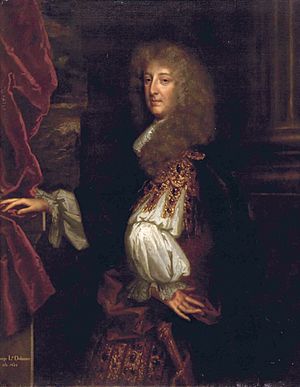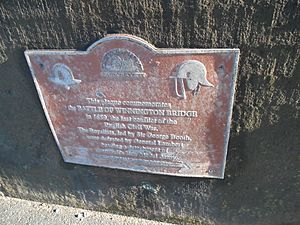George Booth, 1st Baron Delamer facts for kids
Quick facts for kids
Sir
George Booth, Baron Delamer
|
|
|---|---|

George Booth, 1st Baron Delamer
|
|
| Custos Rotulorum of Cheshire | |
| In office 1660–1673 |
|
| MP for Cheshire | |
| In office 1660–1661 |
|
| Personal details | |
| Born | 18 December 1622 Dunham Massey Cheshire |
| Died | 8 August 1684 (aged 61) Dunham Massey |
| Resting place | St Mary the Virgin, Bowdon |
| Nationality | English |
| Spouses | Lady Katherine Clinton (1639-1643) Lady Elizabeth Grey (1644-1684) |
| Children | Seven sons, six daughters |
| Parents | Sir William Booth (died 1636); Vere Egerton (died 1629) |
| Occupation | Landowner, soldier, politician |
| Military service | |
| Allegiance | |
| Years of service | 1642 to 1646 |
| Rank | Colonel |
| Battles/wars | First English Civil War Manchester 1642; Preston 1643; Siege of Chester; Booth's Uprising |
George Booth, 1st Baron Delamer (born December 18, 1622 – died August 8, 1684) was an important English landowner and politician. He came from Cheshire, a county in England. He served as a Member of Parliament (MP) from 1646 to 1661. An MP is a person elected to represent a group of people in the national parliament. After 1661, he became a member of the House of Lords as Baron Delamer. The House of Lords is the upper house of the UK Parliament.
George Booth was part of a group called the "moderate Presbyterians." These were people who wanted to change the Church of England to be more like the Presbyterian church. He fought for the Parliament during the First English Civil War. This was a big conflict between the King and Parliament. After the war, he became an MP for Cheshire. He kept this job even during the time when England was a republic, known as the Protectorate.
Later, George Booth was suspected of trying to bring King Charles II back to the throne in 1655. In 1659, he led his own attempt, called Booth's Uprising. This uprising failed, but Booth was not punished. When King Charles II finally returned in 1660, an event known as the Stuart Restoration, Booth was rewarded with a special title. However, he later disagreed with some of the King's decisions, especially about the Church and the King's power. He even supported preventing the King's Catholic brother, James, from becoming king during the Exclusion Crisis (1679-1681). George Booth passed away in August 1684. His son, Henry, later became an important government official.
Contents
Early Life and the Civil War
George Booth was the son of Sir William Booth and Margaret Assheton. His family was very old and lived at Dunham Massey in Cheshire. George followed in his grandfather's footsteps, also named Sir George Booth. Both of them actively supported the Parliament during the First English Civil War.
This war was a fight between those who supported the King and those who supported Parliament. George Booth and his grandfather were on Parliament's side, often called the "Parliamentarians." In 1645, George Booth was chosen to be a Member of Parliament for Cheshire. This was during a long period of Parliament called the Long Parliament.
Fighting for Parliament
During the Civil War, George Booth became a Colonel, a high rank in the army. He fought in several important battles. These included battles in Manchester in 1642 and Preston in 1643. He also took part in the Siege of Chester. A siege is when an army surrounds a city to try and capture it.
After fighting for a few years, George Booth stopped being a soldier in 1646. This was because he was elected as an MP for Cheshire. Being an MP meant he would now serve Parliament in a different way, through politics.
Life After the War
After the Civil War ended, England went through a period without a king. This time was called the Interregnum. George Booth continued to be involved in politics during this time. In 1653, he was chosen to be part of a special Parliament called the Barebones Parliament.
He was also elected as an MP for Cheshire in later Parliaments. These included the First Protectorate Parliament in 1654 and the Second Protectorate Parliament in 1656. In 1655, he was given important jobs. He became a military commissioner for Cheshire and a treasurer for the war effort. This meant he helped manage money for the army.
Working in Parliament
After a while, the government changed again. A new Parliament, called the Rump Parliament, took over. George Booth was one of the members who had been removed from Parliament earlier. He tried to get his seat back but was not successful at first.
Even though he had fought for Parliament, many people who supported the King, called "Royalists" or "Cavaliers," started to see him as someone who might help their cause. They believed he wanted the King to return. In 1659, someone told the King that Booth was a "Presbyterian" but a good man. They thought the King could trust him to help bring back the monarchy. This made George Booth one of the main leaders who worked with the Royalists to bring back the King. This event is known as the English Restoration.
The Uprising of 1659
A plan was made for an uprising across different parts of England on August 5, 1659. George Booth was given a special order from King Charles II. This order told him to lead the forces in Lancashire, Cheshire, and North Wales.
On August 19, Booth and his men took control of Chester. He then announced that they were fighting "for the freedom of Parliament, of the known laws, liberty and property." After this, they started marching towards York. However, the government knew about the plan. Other parts of the uprising failed. General John Lambert's army quickly moved in and defeated Booth's men. This happened at the Battle of Winnington Bridge near Northwich.
Booth managed to escape by dressing up as a woman. But he was caught on August 23 in Newport Pagnell while getting a shave. He was then sent to prison in the Tower of London.
The King Returns
Even though he was imprisoned, George Booth was soon set free. He returned to Parliament in 1660. This Parliament was called the Convention Parliament. He was one of twelve members chosen to deliver a message from the House of Commons to King Charles II. The King was in The Hague at the time.
A New Title and Role
In July 1660, George Booth received a gift of £10,000 from Parliament. He had actually turned down an offer of £20,000, which was a much larger sum. On April 20, 1661, during the King's coronation ceremony, George Booth was given a special new title. He was made Baron Delamer. This meant he became a "peer" and could sit in the House of Lords. He was also allowed to choose six new knights. In the same year, he was appointed Custos Rotulorum of Cheshire. This was an important local role, meaning he was the chief keeper of the county records.
In his later years, George Booth strongly disagreed with some of the government's actions. He felt they were too strict. He passed away on August 8, 1684. He was buried in the Booth Chapel at Bowdon Church.
Family and Legacy
George Booth was married twice. His first wife was Lady Catherine Clinton. They had one daughter named Vera Booth. After Lady Catherine passed away, he married Lady Elizabeth Grey. With Lady Elizabeth, he had seven sons and five daughters.
His second son, Henry, took over his titles and family estates. These included Dunham Massey Hall and Staley Hall. Henry later became an Earl, which is an even higher noble title. While the Earldom ended when Henry's son died in 1758, the Baron title of Delamer continued for another generation. It finally ended when the 4th Baron died in 1770. The very old family title of "Baronet" then passed to a distant cousin, the Reverend Sir George Booth.
| Name | Birth | Death | Notes |
|---|---|---|---|
| By Lady Catherine Clinton | |||
| Vere Booth | 19 July 1643 | 14 November 1717 | unmarried; Canonbury House, Islington |
| By Lady Elizabeth Grey | |||
| William Booth | 17 April 1648 | 20 Jan 1661 | |
| Henry Booth, 1st Earl of Warrington | 13 Jan 1652 | 2 Jan 1693/94 | |
| Charles Booth | died at Paris | ||
| George Booth | 1726 | married Lucy Robartes | |
| Very Rev Robert Booth | 1662 | 8 Aug 1730 | |
| Elizabeth Booth | 4 July 1681 | married Edward Conway, 1st Earl of Conway; no surviving issue | |
| Diana Booth | 7 October 1713 | married 1677, Admiral Sir Ralph Delaval, 2nd Bt; married 21 October 1699, Sir Edward Blackett, 2nd Bt | |
| Cecil Booth | 16 May 1711 | unmarried | |
| Ann Booth | died young | ||
| Jane Booth | died young | ||
| Sophia Booth | died young | ||
| Nevill Booth | 1667 | 1685 | merchant adventurer |


